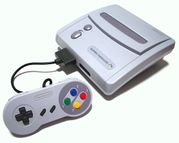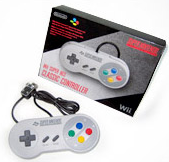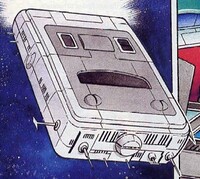Super Nintendo Entertainment System
Template:System-Infobox Template:LLQuote
The Super Nintendo Entertainment System (abbreviated to SNES, Super NES or Super Nintendo, Japanese: Super Famicom; also called in early development NES2 or Nintendo Entertainment System 2) is a video game console created by Nintendo. It was the successor to the original Nintendo Entertainment System and rivaled in performance to the Sega Mega Drive/Genesis. It had many popular games, including Super Mario World, Super Mario All-Stars and Super Mario World 2: Yoshi's Island. Other popular titles are Super Mario RPG: Legend of the Seven Stars and Mario Paint.
The Super Famicom was released in Japan on November 21, 1990 while the Super Nintendo Entertainment System was released in America on August 13, 1991, in Europe in April 1992 and in Australia in July 1992. They were discontinued in 1999, followed by the Famicom model and the SNES/Super Famicom games which discontinued in 2000. It remained popular throughout the 32/64 bit era, selling 49.10 million units during its lifetime. Nintendo also worked with Sony to create the planned add-on, the SNES CD to rival against Sega CD. However, Nintendo's cooperation with Sony crumbled so the SNES CD was moved to Philips for a short time. The project resulted in the CD-i.
The SNES was re-released as the SNES 2, being released at the same time as the Nintendo 64. As well as this, it was smaller and lacked the eject button. It also could not output the S-Video and RGB signals.
During the SNES era, Nintendo and Sega were at the peak of their rivalry, so in many of the Mario games there were elements that mocked the Sonic the Hedgehog series and vice versa. In Donkey Kong Country 2: Diddy's Kong Quest, Sonic's boots and the plasma gun from Earthworm Jim are seen next to a bin and labeled "no hopers". In Super Mario World 2: Yoshi's Island, there are blue hedgehog enemies that greatly resemble Sonic the Hedgehog.
Super Famicom
The SNES was based on a Japanese console called the Super Famicom. Famicom was a portmanteau of Family and Computer. There are obvious performance and aesthetic differences between the two consoles. It was re-released as a Super Famicom Jr., matching a USA SNES 2, but obviously, with the same differences as the SNES 1 and Super Famicom had.
The PAL SNES is a mix between the Super Famicom and the USA SNES, keeping the design of the Super Famicom, but using the name from the USA version.
Accessories
SNES Controller
The SNES Controller is the main controller for the SNES which had a layout which popularized the layout used by most modern controllers. It was also the first controller to have shoulder buttons.
The American controller is slightly different from the Japanese and the PAL controllers. Instead of the different coloured buttons the A and B buttons were purple and the X and Y buttons were lavender.
It has the ,
,
, and
buttons and the
![]() from the NES, plus four extra buttons: the
from the NES, plus four extra buttons: the ,
,
, and
buttons.
There is also a Wii adaption of the SNES controller for use as a substitution for the Classic Controller with games that support said controller.
SNES Mouse
The SNES Mouse was an accessory for certain SNES games. It was compatible only with the SNES and was thus only used in the early-to-mid-1990s. The SNES Mouse mimics the appearance and action of an actual computer mouse; the SNES Mouse controlled the Stripe Pointer in some Mario games.
The SNES Mouse was originally bundled with Mario Paint and a mouse pad for $59.95.
Mario Games Compatible With the SNES Mouse
- Mario Paint
- Mario & Wario
- Mario's Early Years! Fun with Letters
- Mario's Early Years! Fun with Numbers
- Mario's Early Years! Preschool Fun
- Undake 30 Same Game Daisakusen Mario Version
Super Scope
- Main article: Super Scope
The SNES Super Scope is a light gun accessory for the SNES. It has one "fire" button for shooting, either in single bursts or a constant stream, depending on whether or not its on/off switch is set to "turbo". It also has a second "cursor" button and a "pause" button. It was used for very few games, including one Mario title, Yoshi's Safari.
Appearances in the Mario series
A spaceship shaped like the PAL version of the SNES appeared in the 1997 Club Nintendo comic, "Die Jagd nach dem Nintendo 64: Krawall im All". It was used as a metaphor, referring to the discontinuation of the console, and the launch of the Nintendo 64. In the comic, Mario and Luigi traveled with this spaceship, in search for a new one. During their quest they had to compete against Wario and Bowser who chased after the new spaceship as well. At the end of the comic, the spacecraft turned out to be the Nintendo 64 and the plumbers went on to take possession of it (abandoning the SNES-spaceship), being hailed by several of their friends. The SNES is also used as the setting for the microgame Super Nostalgic Entertainment System in WarioWare: Smooth Moves. In Donkey Kong Country 2: Diddy's Kong Quest, giant SNES controllers appear in both Monkey Museum and the Interior of The Flying Krock.
Game gallery
- Original DKC3 box US.jpg
- ENTIRE warioMario box.JPG
- SMK BoxCover2.jpg
- TAT.jpg
- Gazou-samemario.gif
Trivia
- If you like playing SNES/Super Famicon games on a computer, get Snes9x. It is the best SNES/Super Famicon emulator available for Windows and Mac OS X.
See Also
- Super Game Boy, which makes it possible to play Game Boy games on the SNES.

























